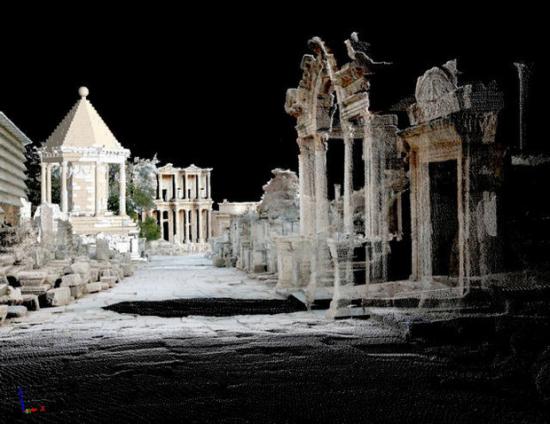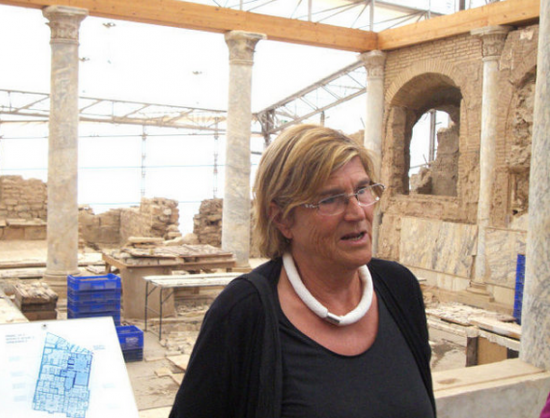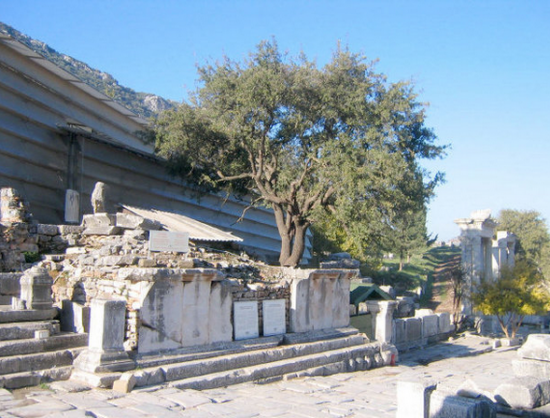John Bordsen
Source - http://www.newsobserver.com/2013/02/24/2697973/archaeologist-says-bones-found.html#storylink=rss

Curetes was one of the main streets in ancient Ephesus, and the site of the long-destroyed Octagon. This photo has been manipulated to superimpose a facsimile of the Octagon in its location, at left. BARBARA THURSWALDNER — COURTESY OF HILKE THUR
Long-buried bones and a missing monarch. Add some historical notoriety and modern technology and you have a heck of a captivating, science-driven story.
Just this month, it was announced that bones found under a parking lot in Leicester, England, belonged to King Richard III. DNA evidence, according to the lead archaeologist at the excavation, proved this “beyond a reasonable doubt.”
For Hilke Thur, a Vienna-based archaeologist at the Austrian Academy of Sciences, a similar quest awaits empirical closure. The locale is more exotic – western Turkey – and the evidence is much more difficult to analyze: The bones in question are a bit more than 2,000 years old.

What took her to Ephesus
“I’m an architect as well as an archaeologist, and Ephesus – a large and important city on the coast of Asia Minor centuries before it became part of the Roman Empire – has long been one of the biggest archaeological sites. It is the main excavation of the Austrian Archaeological Institute.
“I was a student when I started working there in 1975, and have based a great deal of my career around the site. From 1997 to 2005, I was assistant director of the Ephesus excavations.
“An English engineer directed the first archaeological digs there in 1869, but since 1895, only Austrian-led projects have permission to do that, though Turks sometimes have excavations. I’d like to add that it’s quite an international team there, with researchers from all over the world.
“My specialty is interpreting buildings and monuments. The excavations of one monument, The Octagon, began in 1904. In 1926, a grave chamber was found inside The Octagon. The skeleton inside it has been interpreted to be that of a young woman about age 20.”

The actual Octagon site today: Archaeologist Hilke Thur believes bones found in a grave chamber on the site are those of Arsinoe IV, Cleopatra’s half-sister. HILKE THUR
What thickened the plot
“When I was working with the architecture of The Octagon and the building next to it, it wasn’t known whose skeleton was inside. Then I found some ancient writers telling us that in the year 41 B.C., Arsinoe IV – the half-sister of Cleopatra – was murdered in Ephesus by Cleopatra and her Roman lover, Marc Antony. Because the building is dated by its type and decoration to the second half of the first century B.C., this fits quite well.
“I put the pieces of the puzzle together.”
The eight-sided clues
“In antiquity, ordinary people were not buried within the city. That privilege was only for special people – those with an aristocratic background, or people who did special things for their city. So the body must have belonged to a special person. Also, the skeleton was of a woman.
“Then there is the shape of the building. While The Octagon exists only as ruins today, its pieces have been photographed. The images were digitized and ‘virtually rebuilt’ on a computer. The shape of the building, an imperial grave monument, resembles the famous Lighthouse of Alexandria, one of the Seven Wonders of the Ancient World. The lighthouse, destroyed centuries ago, was built at Alexandria, on the Egyptian coast, by the Ptolemy dynasty from which Cleopatra and Arsinoe IV were descended.
“The center portion of the lighthouse tower was octagonal, which was quite unusual at the time.”
Forensic evidence
“The site of The Octagon has a grave chamber. It was opened in 1926, but the opening was very small, and no one entered it until later on.
“The skull had been removed for tests; it disappeared in Germany during World War II. But there are photos of the skull, and notes written down by those who examined it.
“In 1985, the back side of the chamber became accessible, and I re-found the skeleton – the bones were in two niches. The body was removed and examined. The bones were found to be those of a woman younger than 20 – 15 or 16, perhaps.
“The revised age was used for arguments against my theory of the body belonging to Arsinoe IV, but those arguments didn’t find anything to disprove my theory.
“This academic questioning is normal. It happens. It’s a kind of jealousy.”
What would prove her theory
“They tried to make a DNA test, but testing didn’t work well because the skeleton had been moved and the bones had been held by a lot of people. It didn’t bring the results we hoped to find.
“I don’t know if there are possibilities to do more of this testing. Forensic material is not my field.
“One of my colleagues on the project told me two years ago there currently is no other method to really determine more. But he thinks there may be new methods developing. There is hope.”
A monarch, a murder
In 48 B.C., Cleopatra, queen of Egypt, was trying to keep her throne amid rivalries within her dynasty. She fled to the port of Alexandria and linked up with Roman general Julius Caesar. Cleopatra’s younger half-sister, Arsinoe IV, whipped up Egyptians against Caesar and Cleopatra. Rome sent reinforcements to secure Cleopatra’s reign and the captured Arsinoe was taken to Rome to be in Caesar’s victory parade.
Important captives were usually executed. But to Cleopatra’s dismay, Caesar granted Arsinoe a life in exile in Ephesus; she was given sanctuary in the Temple of Artemis there.
Caesar was assassinated in 44 B.C.; Cleopatra took up with Roman general Marc Antony, who had Egyptian aspirations of his own. In 41 B.C., Cleopatra got Antony to have Arsinoe murdered at the Ephesus temple – a scandal that shocked the Roman Republic. A decade later, jockeying for control in what was becoming the Roman Empire, Antony and Cleopatra invaded Egypt and met their end.
“Cleopatra: A Portrait of a Killer” is a jazzed-up, six-part 2009 British TV documentary about this that you can find on YouTube (http://bit.ly/abcL6u).John Bordsen